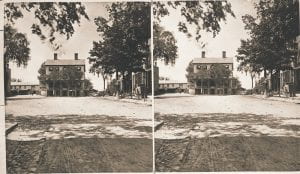Between the Jones Library Archives and Special Collections and the Emily Dickinson Museum, a wealth of information brought early Amherst to life! We, as interns, have spent the past few weeks learning the importance of the digital; from important text analysis tools to the ethics of distribution. However, the value of analyzing source material in the physical form and in space cannot be underestimated.
Particularly striking about our visit to the Jones Library Special Collections was the John Lovell photography collection. Lovell (1825 – 1903) was a professional photographer who came to Amherst in 1856 and established the Amherst Picture Gallery, continuing a long history of College imagery and extending the two-decade old technology of modern photography to Western Massachusetts. Throughout his professional life at Amherst, he produced compelling images of the College architectural landscape of then (more) humble town of Amherst. The collection revealed gems I would not have searched for online such as the view of Main Street in the 1860s shown below. Stumbling into such gems can be a valuable addition to primary research in the digital form.

The visit to the Emily Dickinson Museum equally added more context to my investigation of early Amherst. Learning about Emily Dickinson’s connection to the College through her brother Austin, an Amherst College graduate whose involvement with the college extended beyond his graduation, and the social networks that existed around the mid-nineteenth century fleshed out the information I’ve gathered so far on the persons influential in the construction of Amherst College buildings and its guiding pillars.
While the value of digitally accessible sourcing is unquestionable, it need not come at the expense of analyzing physical copies and site visits. Both forms of primary sourcing work alongside each other to paint a holistic picture of spaces and stories in history. Thus, Lovell’s dusty prints and Dickinson’s remodelled bedroom made early Amherst come even more alive.